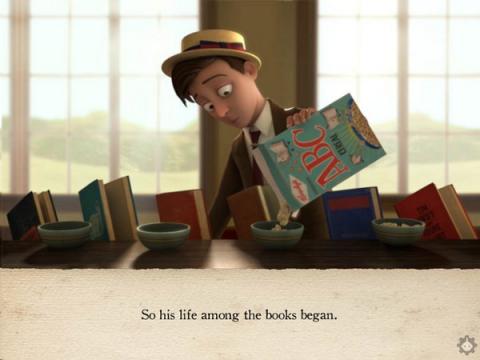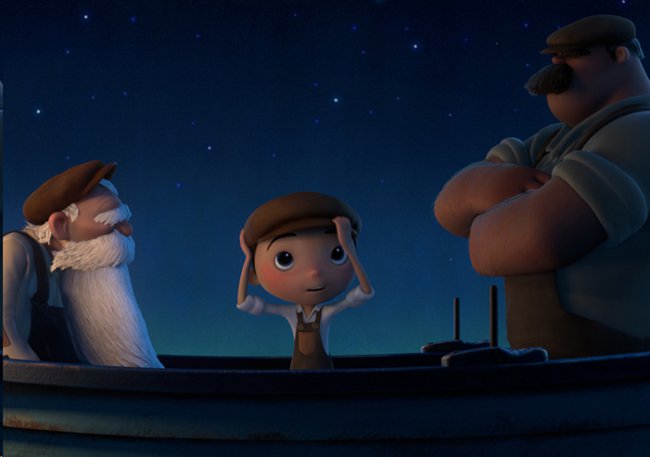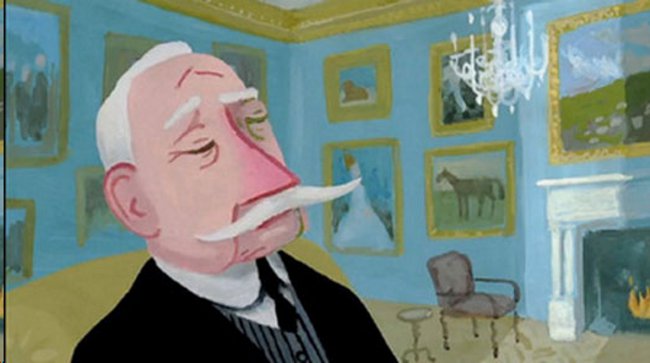Celebrating the Art of Animated Shorts at the Oscars

Animation offers viewers both the sensory effect of a film and the altered, stylized universe of a painting. There is something moving and poetic about animation that live-action is unable to access. Since 1931, the Academy of Motion Pictures and Sciences has awarded an Oscar for Best Animated Short Film.
Five animated shorts have been nominated this year. They are, in alphabetical order: Dimanche, The Fantastic Flying Books of Mr. Morris Lessmore, La Luna, A Morning Stroll and Wild Life.
In the past, opportunities to see these shorts were scarce; but, starting eight years ago, ShortsHD began offering Oscar-nominated shorts for theatrical and cable release. They are currently playing around the country in various art-house cinemas.
Here is a closer look at each of the five animated short films:
Dimanche / Sunday
Dimanche is an entirely hand-drawn film from the National Film Board of Canada, directed by Patrick Doyon. It is the most thought-provoking of the five short films. Dimanche portrays a dreary Sunday afternoon in a small town through the eyes of a boy. The young protagonist is a pleasure to watch. Doyon preserves the boy’s amusing, whimsical perspective throughout the film, and adds humor and imagination along the way. In the boy’s mind, little events, such as finding a coin, take on enormous significance. Adults are often dismissed as materialistic and boring, and the daily routine that he is subjected to is transformed into a surreal experience. Doyon portrays a child-like sense of wonder, but does not idealize the life of a child; rather, he hints at its difficulties and darker sides. The film is lively, intelligent and creative. It mixes the morbid with the humorous, and presents the ordinary in a way that is unusual.
Believing that traditional animation brings out more emotion than computer animation, Doyon created all of the film's animation on paper, painstakingly drawing each of the frames himself. Doyon, 32, is a book and magazine illustrator who lives in Montreal. Dimanche is his first professional effort in film.
The Fantastic Flying Books of Mr. Morris Lessmore
The Fantastic Flying Books of Mr. Morris Lessmore, directed by William Joyce and Brandon Oldensburg, is a beautiful ode to books and reading. The 15-minute American film combines 2D animation techniques with miniatures and computer animation, creating a unique visual hybrid that is simultaneously old-fashioned and cutting edge. It also uses a clever interplay of black-and-white and color. The result is a sublime movie with a charming and nostalgic tone.
Mr. Morris Lessmore, the main character, is modeled after Buster Keaton, the legendary comedic actor and filmmaker of the Silent Era. The Fantastic Flying Books of Mr. Morris Lessmore tells the story of a young man who is swept away by a tornado to a place where books are emotional, alive and can fly like birds. (They also eat alphabet cereal for breakfast.) Guided by Humpty Dumpty when he is unsure what to do, the young man ends up devoting his life to taking care of the books, reading them and writing. This film is perfect for both children and adults, and will especially resonate with book lovers.
Director, William Joyce is an accomplished children's author, animator and retro designer, who has written and illustrated more than 50 children’s books and numerous covers for the New Yorker. Joyce also wrote the story for The Fantastic Flying Books of Mr. Morris Lessmore, which was released as an interactive e-book application for the iPad. Since then, it has sold more than 55,000 copies and was the best-selling app in the world for two weeks. There will, of course, be a print version it, which will become available this summer.

La Luna
La Luna, directed by Enrico Casarosa and produced by Pixar, is a beautifully done and widely appealing short film. In a way, its flawlessness and risk-averse nature become its main flaws. The film has an attractive Italian flavor to it, but it is the same uninsisting amount of Italian flavor that often characterizes Italian-American food. La Luna tells the story of three generations of janitors – a grandfather, a father and a young son – whose job is to sweep on the moon. There for the first time, the boy is torn between the conflicting advice he receives from his elders. The film poses the question: Will the boy find his own identity and his own way of doing things?
The three characters, their rowboat and the ladder to the moon are lovely. Both the visuals and the score are delightful, but the film is lacking in depth. On the bright side, La Luna is sweet, mesmerizing and provides a nice twist at the end.
Enrico Casarosa grew up in Genoa, Italy, a Mediterranean setting which he tries to capture in this short film. He has worked at Pixar for the past 10 years, and has contributed to Up and Ratatouille. He is currently the head story artist for Pixar’s 2013 feature. Despite working with so many collaborators at Pixar, he values auteur films and cites Hayao Miyazaki as his biggest influence. La Luna children’s book is coming out in May, with original watercolor illustrations by Casarosa.
A Morning Stroll
A Morning Stroll, a U.K. film directed by Grant Orchard and produced by Studio AKA, is perhaps the “hippest” of the five shorts. This independent, computer-animated film is innovative, idiosyncratic and exudes modernity. Loosely based on Clausen’s true story, The Chicken, which first appeared in The New York Literary Review in 1986, the film portrays a New Yorker’s early morning encounter with a chicken, thus re-examining the much-contemplated mystery “why did the chicken cross the road?”
The chicken in this film walks down the city street, taps her beak on a door and is let inside. The catch is that the scenario is rendered three times – in 1959, 2009 and 2059 – in increasingly sophisticated styles of animation. Each chapter is structurally the same, but the urban environment, visual aesthetic and music radically change. According to the director, the concept behind the film was inspired by Raymond Queneau’s Exercises in Style, which is a collection of 99 retellings of the same story. The spirit of Orchard’s film is so easygoing that one may not immediately notice the interesting interplay the director sets up: At each 50-year interval, he makes the visuals more sophisticated, going from black-and-white, to color, to 3D, while the nature of the emotional interaction and the narrative become increasingly more simple. He is also able to comment on the different ways we relate to our environment over time.
The film has had a lot of success, winning the Jury Prize at the Sundance Film Festival and the short animation BAFTA, the British equivalent of an Academy Award. There has been so much demand for a phone app featured in the 2009 part of A Morning Stroll that it is now being developed by a games company.

Wild Life
Wild Life, directed by Amanda Forbis and Wendy Tilby, is another entry from the National Film Board of Canada. This short is perhaps the weakest among the five and feels stale in comparison with the others. Using a mixture of computers and hand-painting, the film tells the story of a well-educated British aristocrat who dreams of becoming a cowboy. He moves to Alberta in 1909, but is not prepared to survive in the harsh conditions that await him. The aristocrat attempts to live as he did before, writing letters, playing badminton and bird-watching. The directors show in a very straightforward way how affluence and breeding is no substitute for hard work and practical skills. There are a lot of references and disparate elements introduced within the movie, such as images of a comet, but it does not all work well together. The film is melancholy and lacks both rhythm and a sense of conclusion; the other four films are more infused with spirit and energy. However, the film does show the struggle of the remittance man, who was an important part of Canadian history.
Amanda Forbis and Wendy Tilbis, who are based in Calgary, often work together on animated films and were also nominated for an Academy Award for Best Animated Short Film in 1999.
This year's Oscar-nominated animated shorts are very different from one another, but there are some broad overarching themes that unite them. A common technique throughout (all but Dimanche) is mixing various styles of animation, thus offering a hybrid of traditional animation techniques and newer digital methods. None of the five animated films was done entirely on the computer, with all containing some drawing or painting by hand. As director of Wild Life, Amanda Forbis puts it, “Real paint is more visceral.” Many of these short films have made their way into other media as well, becoming books or phone applications (or both). Finally, like Michel Hazanavicius’ silent film, The Artist, four of the five nominees are dialogue-free, which removes any language barrier and gives them a universality.
Animation is especially powerful when viewed on the big screen and the opportunity to see so many short films at once is a pleasure – like the chance to slip in and out of multiple artistically-constructed realities. After the hour-and-a-half immersion into these films, daily life may look quite different.
Author Bio:
Elizabeth Pyjov is a contributing writer at Highbrow Magazine.




























































































































































































































































































































